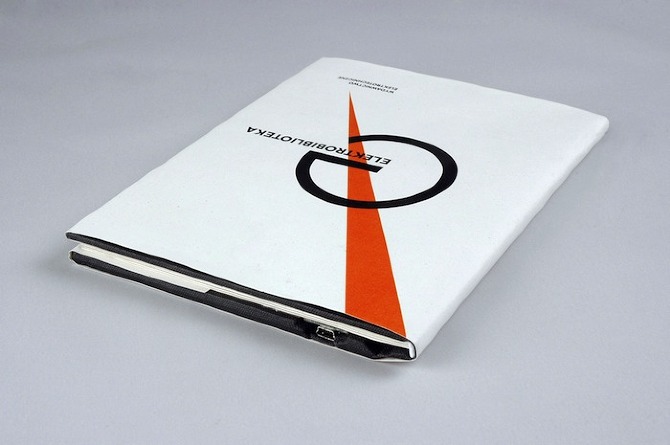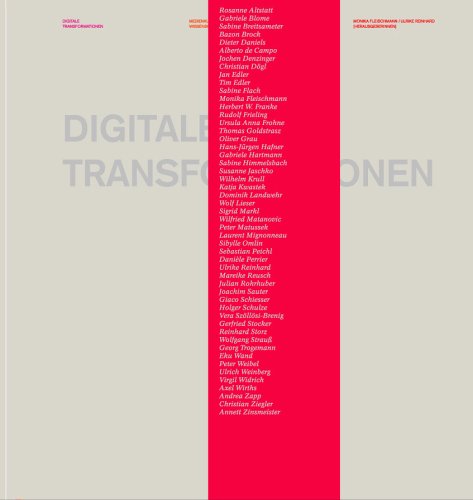Waldek Węgrzyn: Elektrobiblioteka / Electrolibrary (2012)
Filed under augmented book, thesis | Tags: · book, design, e-book, interactive design, interface

A hybrid book project inspired by El Lissitzky’s manifesto published in 1923.
Author: “I was interested in the phenomenon of a book perceived as a kind of interface, which has influenced the way we deal with information. I also wanted to shift the experience typical for print design to the field of digital media. One of the major inspirations was the manifesto ‘The topography of typography’ published in 1923 by a graphic designer El Lissitzky, who has expected a book to be replaced with something he called “electrolibrary”. It seems that his predictions came true.
The final result of the project is the paper book that can be connected to the computer via USB cable. It is able to physically detect which page is currently open and send that information to the Electrolibrary website. By turning pages or touching given illustrations you can navigate through the website and get additional information such as hyperlinks, quotations, movies etc. Of course you can also unplug the cable and read it like a normal book.
The book was intended to be a single object, just for presentation. The great interest in my project that I encounter surprised me. I did not expect that at all, so maybe this project can be developed further.” (source)
Diploma thesis
Multimedia dept, Academy of Fine Arts, Katowice, Poland
Supervisor: Bogdan Król
via Jono van Belle
demonstration video
Lissitzky’s manifesto
View online (HTML) [Polish]
Comment (0)Christian Ulrik Andersen, Geoff Cox, Jacob Lund (eds.): Nyhedsavisen: Public Interfaces, No. 1 (2011)
Filed under newspaper | Tags: · architecture, art, city, interface, public space, software, urbanism

Nyhedsavisen: Public Interfaces is a fake newspaper presenting cutting edge research in an accessible free tabloid format. The newspaper is a 100% genuine copy of the famous Danish newspaper Jyllands-Posten.
The increasing demand for publication of academic peer-reviewed journal articles must be met. Unfortunate examples demonstrate that this may lead to plagiarism. This is not a viable solution. Research must be original and academia is not lacking original content. But perhaps researchers need new visions of how to produce research? Perhaps the readers need new ways of consuming research? Why not imagine academic research as something that can be consumed on a daily basis, in the train or at the breakfast table?
On April 1, at 1 pm, Nyhedsavisen: Public Interfaces was handed out to the public at the metro station ‘DR Byen/Universitetet’ in Copenhagen as well as at the central railway station in Aarhus and the State Library. Also, issues were tactically placed in selected free newspaper stands and at University lunchrooms worldwide.
Emerging from the Digital Aesthetics Research Center and the Center for Digital Urban Living (Aarhus University), the aim of Nyhedsavisen: Public Interfaces is to encompass the changing concept of the ’public’. This is the result of an ongoing research in the computer interface.
The starting point for the newspaper is that the computer interface is a cultural paradigm affecting not only our creative production and presentation of the world but also our perception of the world. Its authors recognize that in the past decade, interfaces have been expanding from the graphical user interface of the computer to meet the needs of different new technologies, uses, cultures and contexts: they are more mobile, networked, ubiquitous, and embedded in the environment and architecture, part of regeneration agendas and new aesthetic and cultural practices, etc. Nyhedsavisen: Public Interfaces investigates these new interfaces that affect relations between public and private realms, and generate new forms urban spaces and activities, new forms of exchange and new forms of creative production.
The newspaper is organised into thematic strands (urban, art, capital) and brings together researchers from diverse fields – across aesthetics, cultural theory, architecture, digital design and urban studies – united by the need to understand public interfaces and the paradigmatic changes they pose to these fields.
All articles derive from an initial conference and PhD workshop held in January 2011, at Aarhus University.
Publisher Digital Aesthetics Research Center & Center for Digital Urban Living, Aarhus University, Aarhus, March 2011
ISBN 87-91810-18-3
Creative Commons Attribution-NonCommercial-ShareAlike License
24 pages
PDF
View online (HTML articles)
Monika Fleischmann, Ulrike Reinhard (eds.): Digitale Transformationen: Medienkunst als Schnittstelle von Kunst, Wissenschaft, Wirtschaft und Gesellschaft (2004) [German]
Filed under book | Tags: · digital art, interface, media art

“Die Publikation Digitale Transformationen beschäftigt sich mit den grundlegenden Transformationen, welche die Kunst und das moderne Leben durch digitale Technologien erfahren. Theoretiker, Künstler und Wissenschaftler kommen neben Produzenten, Förderern und Vermittlern zu Wort, um die digitalen Transformationen in ihren vielfältigen Rollen und an konkreten Beispielen als neue Ästhetik und als Innovationsforschung vorzustellen. In der Kunst mit Informationstechnologien geht es um Bild(er-)findungen auf der Grundlage kommunikativer Prozesse, um begriffliche Strategien und kognitive Methoden. Damit möchten die Herausgeberinnen Ulrike Reinhard und » Monika Fleischmann nicht nur den klassischen Kulturbereich ansprechen, sondern die Medienkunst als künstlerische Position an der Schnittstelle von Technologie, Wirtschaft, Wissenschaft und Kultur denen nahe bringen, die bereit sind, diese Kunstform als einen wichtigen Schlüsselfaktor für neues Denken und Innovation anzuerkennen und zu fördern. Medienkunst zeigt neue Weltbilder. Sie zeigt, wie wir verstehen, was wir sehen und hören. Die Texte geben einen Einblick in Diskurs und Praxis im deutschsprachigen Raum und sind hier nachzulesen.”
Authoren: Rosanne Altstatt, Gabriele Blome & Jochen Denzinger, Sabine Breitsameter, Bazon Brock, Dieter Daniels & Rudolf Frieling, Alberto de Campo & Julian Rohrhuber, Christian Dögl, Jan & Tim Edler, Sabine Flach, Monika Fleischmann 1, Monika Fleischmann 2, Monika Fleischmann & Wolfgang Strauss, Herbert W. Franke, Ursula Frohne, Thomas Goldstrasz, Oliver Grau, Hans-Jürgen Hafner, Gabriele Hartmann, Sabine Himmelsbach, Susanne Jaschko, Wilhelm Krull und Vera Szöllösi-Brenig, Katja Kwastek, Dominik Landwehr, Wolf Lieser, Sigrid Markl & Virgil Widrich, Wilfried Matanovic, Peter Matussek, Laurent Mignonneau & Christa Sommerer, Sibylle Omlin, Sebastian Peichl, Danièle Perrier, Ulrike Reinhard, Mareike Reusch, Joachim Sauter, Giaco Schiesser, Holger Schulze, Gerfried Stocker, Reinhard Storz, Georg Trogemann, Eku Wand, Peter Weibel, Ulrich Weinberg, Axel Wirths, Andrea Zapp, Christian Ziegler, Annett Zinsmeister
Publisher Netzspannung.org, Heidelberg, 2004
ISBN 3934013384
369 pages
Publisher (archived)
PDF (95 MB, updated on 2019-10-13)
Comment (0)
